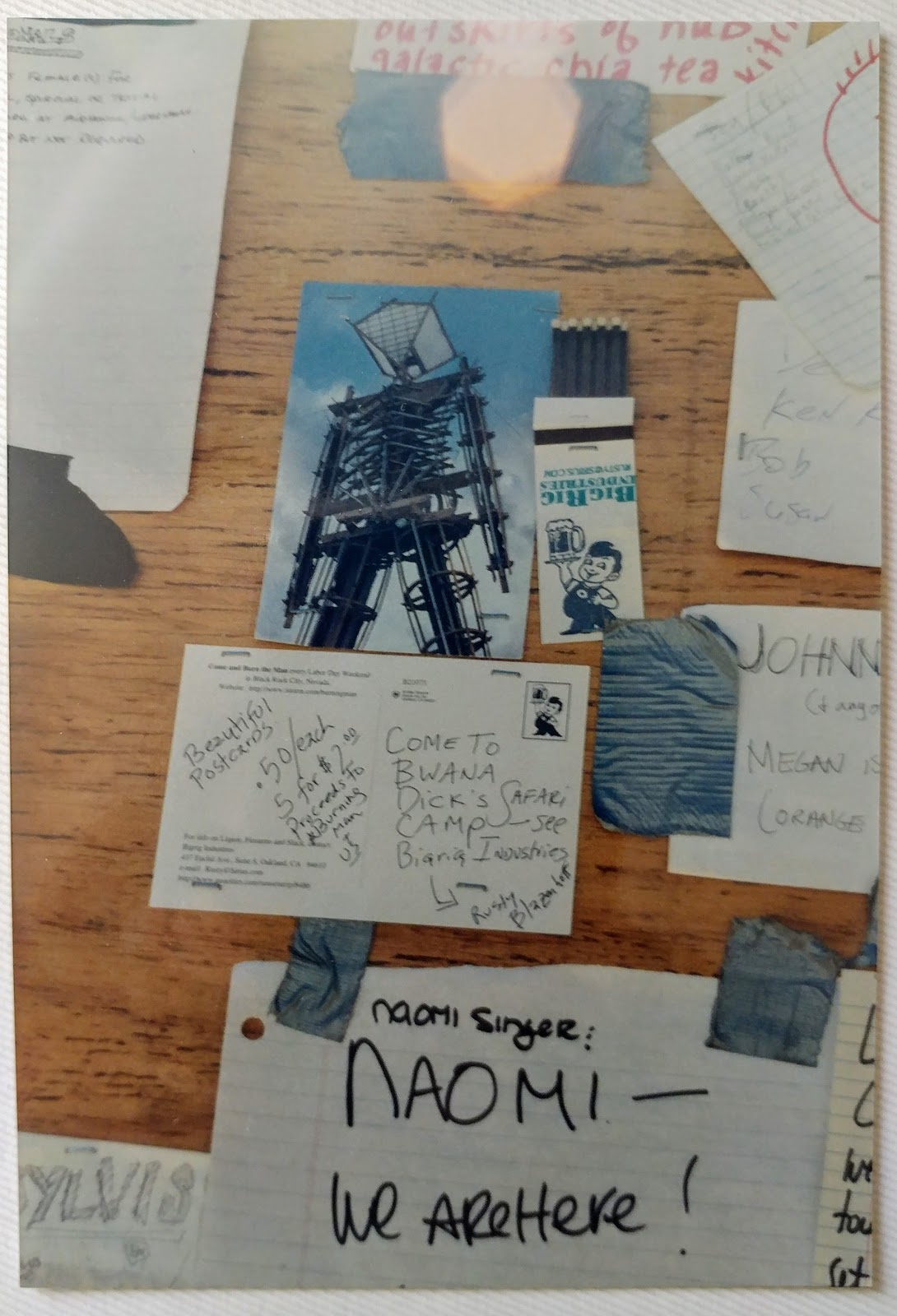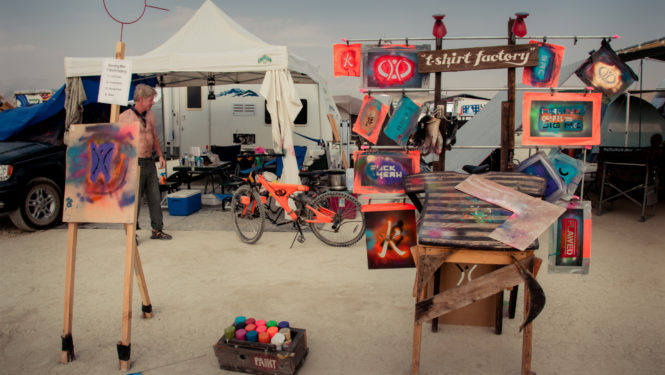This is the first post in a series about Decommodification, one of Burning Man’s 10 Principles and a crucial issue in our culture.
Did you know that there was once merchandise for sale at Burning Man? There was! In 1996, a few of us took the opportunity to sell some stuff. Keep in mind that Larry Harvey didn’t write the 10 Principles until 2004, so “Decommodification” wasn’t officially part of our ethos yet.
Things were different in the nineties

As I prepared for my second Burning Man in 1996, I had an idea: postcards. Stickers were fairly common but, to the best of my knowledge, no one had printed postcards up before. Growing up in a tourist town, I understood the value of a souvenir. It was tangible proof that you had gone somewhere, that you had been “there.” The thought of having a postcard from Burning Man made me laugh. I had to do it. I had planned to just give them away but then, well…
Custom printing was incredibly expensive in the nineties. I don’t remember exactly how much I paid but it was a lot. It was enough where I cringed in shame looking at the extra boxes of cards in my garage for years. But, that summer, I was so invested in the concept of having postcards for Black Rock City that I plunked down the large sum on a credit card. Today, getting postcards printed would be cheap and easy.
But back then it meant finding a wholesale postcard-printing company that catered to the tourist trade. I made an appointment with the only one I could find in the Bay Area and I brought along a photo of the Man I had shot the year before. The salesman had never had a “civilian” inquire about a quote before, and he certainly had never heard of Burning Man. He informed me that the minimum was 10,000 pieces for a print job. The entire population of Black Rock City was under 10,000 people at that point.
What was I thinking?

This might sound strange, but these postcards were my art. My intent was to be absurd, as if to say, “This is how people like us vacation,” with the medium truly being the message. I had never intended to put them up for sale but then I heard some folks were going to be selling things at Center Camp Café, and I thought I’d be dumb to not try to recoup some of the money I was hemorrhaging.
The afternoon I sat there quietly peddling in the shade, two prominent Rangers sat next to me selling their wares: professionally-printed Burning Man t-shirts and glow-in-the-dark frisbees that had the Burning Man logo in the center. I’m not sure how their products sold, but there weren’t all that many buyers for the postcards. Though I did trade some for a t-shirt and a frisbee.
Not everything needs to be bought and sold
My project had failed as a business. In reflection, and I’ve had over 20 years to think about this, I realized by selling the postcards, I had weakened my own value to the community. I had missed the postcard’s real value, a device to authentically connect with my fledgling community.
I’m reminded of something Larry Harvey once said, “Burning Man is like a big family picnic. Would you sell things to one another at a family picnic? No, you’d share things.” He’s right, and in retrospect, I should have taken the opportunity to build deeper, more authentic relationships by giving my postcards away. Selling my postcards was about me and my needs. If I had gifted them, it would have been about the recipient, i.e. a true gift.
With this perspective, I do die a little inside each time I see some model hawking someone’s MOOP-y “hot playa girl uniform” on Instagram. Or when the playa is used as the backdrop for sunglasses, energy drinks, or any number of things that appear on Instagram in the weeks following the event. I’m sad that we still struggle with keeping this part of our culture in check.
As one of the few people ever to experiment with traditional transactions on the playa, I’m here to tell you that commodification just isn’t for us. Though, my failed attempt at vending at Black Rock City changed me for the better and I have since embraced the exquisite joy of dealing in social currency, both on playa and off. I have since come to believe that money sometimes buffers true connection (technology does too, but that’s a story for another day). And that, at Burning Man, it exploits our unique community.
Ahem, your motives are showing
Another thing, I thought someone was yanking my chain when they told me some people consider Burning Man a networking opportunity. Yuck! This is not ok. We can do better than this.
Folks, don’t hide behind your business card. At Burning Man, giving your business card to someone tells the recipient that they are only as valuable as what you can get out of them in the default world. Try being present and bringing gifts of real value to share, ones that express the real you but also aren’t about you.
Your challenge, should you choose to accept it
If you’re new to our community, I humbly challenge you to try our way on for size. Make something. Try gifting instead of selling. Learn how to give an experience without the exchange of money. The default world gives you plenty of opportunities to sell stuff, just leave Burning Man out of it, okay? If you’re an experienced Burner, would you consider appointing yourself an ambassador of the culture and (gently, kindly) make a “you’re doing it wrong” infraction a teaching moment?
In advance, thank you.
Top photo by Abi Bell


absolutely right on!!!
Report comment
Before BMorg took over and Harvey came down from the mountain with the 10 Principles, most things were better.
Report comment
don’t pop the bubble for the new kids. they’ll need it in order to stay righteous.
Report comment
I forgot, they’re trying to have a transformative experience. That’s what they paid for… Never mind, children – the 10 Principles are AWESOME and you’re an AMAZING artist! Life is art! Everything is art. I’m spiritual but not religious!
Report comment
Amen. It was better with just 3 principles.
Participants Only, No Spectators
Leave No
You are not to interfere with anyone else’s immediate experience.
Report comment
Leave No Trace
Report comment
I would say the “bud light” banner skirted it pretty well, nowhere is there any mention of BM and no imagery.
Report comment
the new kids now claim ownership of common words and prior art
Report comment
Larry Harvey was just like Jesus Christ, turning over the tables of the merchant Jews.
Report comment
Your merch table has moved to Haight St. The entire street offering “Playa looks”. The glitters, the glam, the Barry Lyndon, the vintage, the vanity and other cultural appropriation idiocies. Everything you need for the BM “Festival” ready to be consumed. As a vet burner I know that the burner’s community is very alive and well. That said, I can’t but wonder if BM isn’t little by little turning fake….
Report comment
Haight’s been Haight since the ’60’s even before BM. They are the source of BM outlandish persona.
Report comment
I remember i bought a t-shirt from DPW back in 1997 as i was exiting the Playa. I still wear it today =)
BTW, DPW sold shirts to pay for booze, drinks and food for resto long before Resto team was formed.
Report comment
What happened to all the postcards?
Report comment
At some point, during one of my many moves, I parted with all but 50 of them.
Report comment
Would you like me to send you one?
Report comment
I would love one please :)
Report comment
You’ve had years of opportunities to drag those boxes back to the playa for gifting!!!!!
Report comment
So, I stopped going for many years soon after that and when I returned, I had freed myself of nearly all of them.
Report comment
Ah yes. I remember my old Burning Man T Shirt. I think I ordered it online shortly after my first burn in 1998. I don’t think I ever wore it because it just didn’t feel right.
Report comment
Wonderful post! We are linking to this great post on our website. Keep up the great writing.
Report comment
Comments are closed.